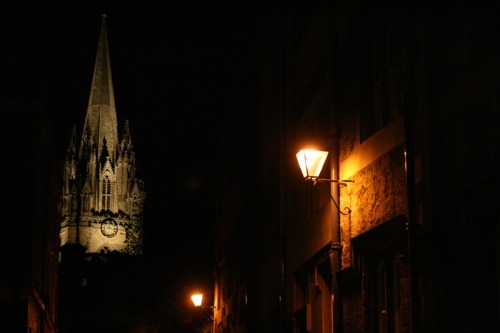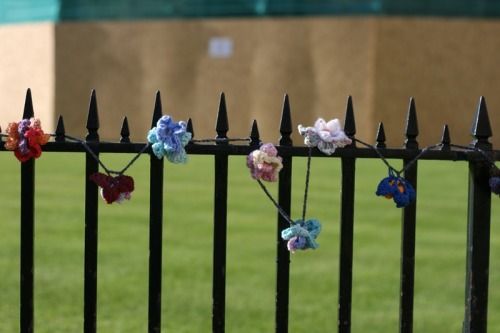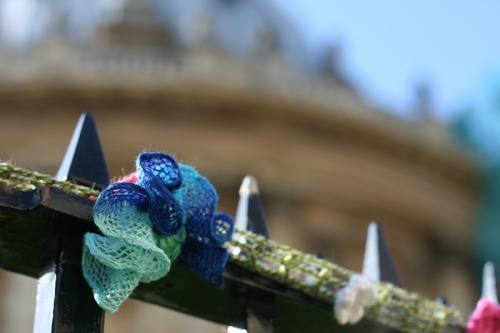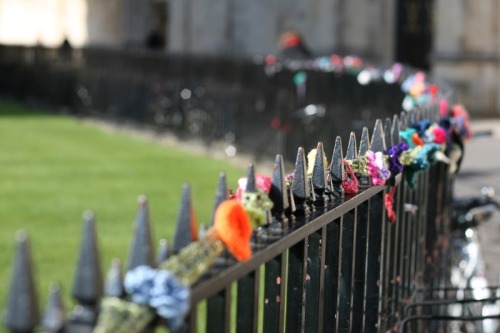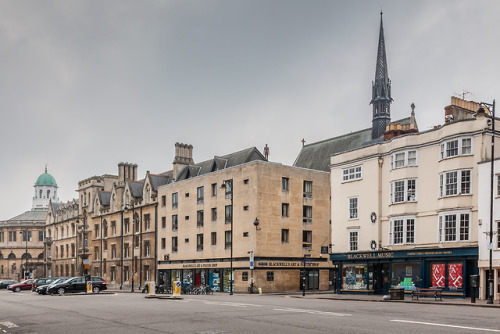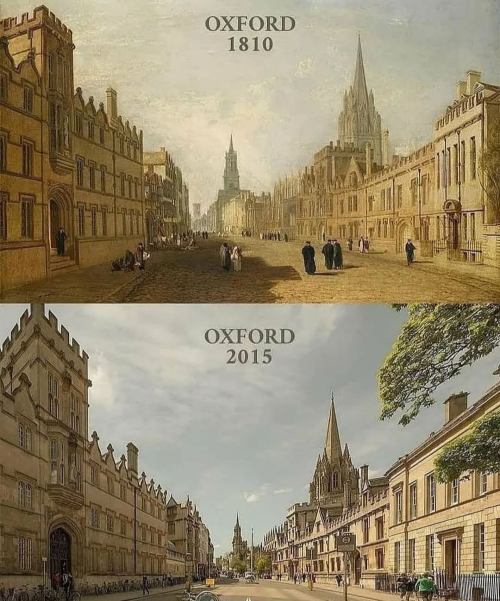#oxford
Guerilla knitting in Radcliffe Square, Oxford.
I almost walked straight past these - I only stopped because the grass looked newly turfed, and I was about to walk away when the flower on the end of the chain caught my eye.
Post link
Philip Pullman, The Secret Commonwealth (2019)
Lyra stood up, feeling every one of the separate pains and injuries. The hand was worst; she took a very little of the rose salve on her right forefinger and rubbed it in as gently as a butterfly landing on a grass blade. Then she put the salve in her rucksack with the alethiometer, and stepped away from the fire and towards the tumbled ruins.
The moon was climbing the sky, and the vast sweep of the Milky Way stretched above, every one of those minute specks a sun in its own system, lighting and warming planets, maybe, and life, maybe, and some kind of wondering being, maybe, looking out at the little star that was her sun, and at this world, and at Lyra. Ahead of her the dead bones of the town lay almost white in the moonlight. Lives had been spent here—people had loved one another and eaten and drunk and laughed and betrayed and been afraid of death—and not a single fragment of that remained. White stones, black shadows. All around her, things were whispering, or it might only have been night-loving insects conversing together. Shadows and whispers. Here was the tumbled ruin of a little basilica: people had worshipped here. Nearby a single archway topped with a classical pediment stood between nothing and nothing. People had walked through the arch, driven donkey carts through, stood and gossiped in its shade in the heat of a long-dead day. There was a well, or a fountain, or a spring: at any rate, someone had thought it worth cutting stones and forming a cistern, and a representation of a nymph above it, now blurred and smoothed by time, the cistern dry, the only trickle that of the insect sounds.
So she walked on, further and further into the silent moonscape of the City of the Moon, the Blue Hotel.
Post link
Cephalopod Week
This week is #CephalopodWeek, and today, we bring you this cephalopod who has seen better days.
The beautiful shell of this poor Nautilus was too much temptation for the artists and craftspeople of the Renaissance and Baroque period who fashioned indulgent Nautilus cups from gold, silver and real Nautilus shells.
Though they have survived five mass extinctions, Nautilus are now endangered by their harvesting by the shell trade. In more ways than one, ornaments made from Nautilus shells belong in museums.

Windrush Day

On the third official Windrush Day, we recognise the half a million people who travelled to the UK after World War II, and celebrate the contributions of the Windrush generation and their descendants to our communities here in the UK.
Our ‘Nice Cup of Tea?’ display is a collaboration with members of Oxford’s African Caribbean and Windrush communities, highlighting hidden stories of empire and slavery behind the tea trade. You can see it on display in Gallery 40.
Hans Coper 100

Hans Coper was one of the 20th century’s great potters and artists. Our ongoing display celebrates his centenary by uniting items from our collection, more than 30 loans from private collectors and several seldom-seen, often intimate photographs of Coper at work.
Visit for FREE until 26 September, but don’t forget that a General Entry ticket is required.
https://ashmolean.org/event/hans-coper#/
A Tang Dynasty Goose

Happy Tuesday, everyone! Here is a small goose to brighten up your day.
This little goose is from 7th-8th century China, under the Tang Dynasty, and is made from hand-modelled earthenware. It would have been used a burial good.
Geese have featured prominently in Chinese rituals for many centuries: during the Han dynasty, from 206 BC to 220 AD, it became a symbol of nobility because of their similarity to the swan. Later on, during the Tang Dynasty, they were more often associated with marriage rites, as they were given as wedding gifts or involved in various elements of the wedding ceremony.
Burial goods or tomb figures were common in Tang Dynasty China, and it was thought that the figures represented would be available to the deceased in the afterlife.
Wu Guanzhong

Our FREE exhibition of works by Chinese artist Wu Guanzhong (1919–2010) is now open in Gallery 11.
Throughout the course of his career, Wu Guanzhong engaged in the traditions of both European and Chinese painting, studying at the National Academy of Art in Hangzhou and the Ecole Nationale Supérieure des Beaux-Arts on Paris.
During the Chinese Cultural Revolution, he sparked national debate with an article advocating abstract art. Of the two conflicting painting movements of twentieth-century China, he wrote: “Nationalisation of oil painting and modernisation of Chinese ink painting are actually twins. When I encounter a problem in oil painting I transplant it into ink painting and sometimes it’s solved. Vice versa, when a problem couldn’t be solved in ink painting, I would try it in oil painting…”
This exhibition explores Wu Guanzhong’s work through the decades from the 1950s onwards. See it until 30 August in Gallery 11. Free, but a General Entry ticket is required.
ashmolean.org/event/wu-guanzhong
‘Tree Roots’, 1980s.
Coming Soon - Tokyo: Art & Photography




Our next major exhibition will explore Tokyo through the vibrant and varied arts it has generated over 400 years, from its beginnings as the headquarters of the Tokugawa shoguns in the early 1600s to the sprawling modern metropolis and dynamic centre of art, photography and design it is today.
Members will have access to a priority booking period, and will also be able to book into a private view on the day before the exhibition opens to the public. Become a Member today for access to these perks.
Opening 29th July. Find out more: ashmolean.org/tokyo
Tokyo from Utsurundesu series by Ninagawa Mika, 2018–2019
Good Evening Sumida River by Sugiyama Motosugu, 1993
Uguisudani-zu by Aida Makoto, 1990. Mineral pigments, acrylic on sex phone cards on panel
Tokyo Station, Scenes of Last Tokyo by Onchi Kōshirō, 1945.
Museum Week: Eureka!

The term ‘eureka’ comes from the ancient Greek word 'heúrēka’, which literally means 'I have found it!’ It’s also closely linked to the word 'heuristic’, which refers to something that serves as an aid to learning, discovery or problem solving.
This artwork represents a true 'eureka!’ moment in art history: painted by Italian artist and mathematician Paolo Uccello, it is one of the earliest examples of the use of a vanishing point to achieve a sense of perspective in a painting. A vanishing point is the place at which receding parallel lines appear to converge.
Described as 'intoxicated’ by perspective, Uccello studied the concept carefully over many years. He applied his mathematical and analytical mind to his art in order to reconstruct objects in three-dimensional space.
This work, alongside many others that Uccello produced, became a model for other artists who sought to make their works more realistic and life-like. He inspired the likes of Leonardo da Vinci and Albrecht Dürer, and left an enduring legacy with this paintings.
See 'The Hunt in the Forest’ by Paolo Uccello (1397–1475) in our Italian Renaissance gallery.
Museum Week: Children’s Eyes



Today’s #MuseumWeek theme is ‘Children’s Eyes’, which is a wonderful reminder for us to look at the world with the same sense of wonder and curiosity as a child
Does anyone remember our #IsolationCreations fun last year? At the start of the first lockdown, we shared an object everyday and ask you to share your creative responses. We had a number of responses from kids, and these were just a few of our favourites! We love the bright colours, the mixed media and the highly original perspectives on these objects from our collection.
If you were to view the world through the eyes of a child, what might you see differently today?
Museum Week: Behind the Scenes



Today’s #MuseumWeek theme is one of our favourites - Behind the Scenes These photos offer a sneak peek inside our new Ancient Middle East gallery, opening 26 June.
This gallery will take you on a journey across some 10,000 years. You’ll be able to explore village life at the dawn of farming, discover the world’s first cities and the invention of writing, and imagine what life was like in magnificent palaces and temples. You can also listen to Sumerian poetry and write in cuneiform, encounter the art of empires reaching from Iran to Egypt - and find out why the objects that tell these stories are in Oxford.
Stay tuned for more information and come check out the new gallery later this month! Don’t forget that FREE tickets are required for General Entry to the Museum.
Two Green Dishes
These ceramic dishes come from quite different parts of the world, but tell an interesting story of cross-cultural influence.

The first dish with trailed green decoration is from 10th-century Iraq, during the Abbasid Period which lasted from AD 750–1258. The Abbasid Period is one of the most prolific moments of ceramic production in the Islamic world, with lots of experimentation with glazes and surface decoration inspired by foreign trends as well as local demand.
Around the time this dish was made, Chinese ceramics had become all the rage with Muslim potters. Many began collecting and imitating the range of ceramic styles produced there: the choice of the green glaze we see on the Iraqi dish is reflected in the second dish, which was made in Tang Dynasty China centuries prior.

Walter Sickert

Walter Sickert, one of the most influential British artists of the 20th century, was born #onthisday in 1860. He introduced the subjects and techniques of the French Impressionists into English art.
We have a number of Sickert’s works in our collection, including this one, called ‘Ennui’. Painted in 1917–1918, it is his interpretation of the boredom of married life, and is the last of his five paintings of the subject. The models were Hubby, an old school-friend of Sickert’s who had fallen on hard times, and whom Sickert looked after; and Marie Hayes, who may have been Hubby’s wife, and who modelled for Sickert on several occasions. He puffs contentedly on a cigar, while she stares hopelessly at a glass case of stuffed birds.
It is thought that this painting is more successful than his original, as the brighter colours and patterns paired with a smaller canvas size contribute to a more claustrophobic atmosphere.
Virginia Woolf saw this work at an exhibition in London in 1933, and felt compelled to write about it. Listen to our podcast with Dame Hermione Lee, Professor of English Literature at the University of Oxford, to find out more about the work and what Woolf made of it
ashmolean.org/professor-dame-hermione-lee-ennui-walter-richard-sickert
HOME LEARNING: Anglo Saxons

Have you seen our new Anglo Saxons home learning pack yet? ✏️
Travel back in time to Anglo Saxon England with a short video from our Learning team, try your hand at a quiz and have a go at two jigsaw puzzles. You can also learn how to make your own Anglo Saxon brooch in our short craft activity video.
Give it a try today: ashmolean.org/home-learning-anglo-saxons
These coins are from the Crondall Hoard, which was buried before AD 650 and includes the earliest-known Anglo Saxon coins. The hoard was found in Hampshire in 1828 and came into our collections in 1944.



